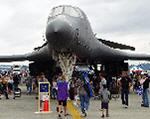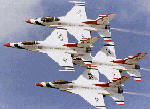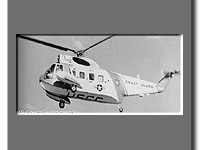
|
Description
| Notes: Amphibious search/rescue transport (3 CREW) . | |||
| Manufacturer: | Sikorsky |
| |
| Base model: | H-52 | ||
| Designation: | HH-52 | ||
| Version: | A | ||
| Designation System: | U.S. Air Force | ||
| Designation Period: | 1948-Present | ||
| Basic role: | Helicopter | ||
| Modified Mission: | Search and Rescue | ||
| See Also: | |||
Specifications
Propulsion
Performance
Examples of this type may be found at
| Museum | City | State |
| American Helicopter Museum | West Chester | Pennsylvania |
| Aviation Hall of Fame & Museum of New Jersey | Teterboro | New Jersey |
| Intrepid Sea-Air-Space Museum | New York | New York |
| Mid-Atlantic Air Museum | Reading | Pennsylvania |
| National Museum of Naval Aviation | NAS Pensacola | Florida |
| New England Air Museum | Windsor Locks | Connecticut |
| Pima Air & Space Museum | Tucson | Arizona |
| Selfridge Military Air Museum | Selfridge ANG Bas | Michigan |
| USS Alabama Battleship Memorial Park | Mobile | Alabama |
HH-52A on display
Recent comments by our visitors
| Harold R. Bratton Campbellsburg, KY | I was stationed at AR&SC ECity from Nov. 68 to Feb. 72.
Was an AM2 and worked on the 52 line overhauling plane after plane. Worked on line crew my last year or so. We handled all the test flights. Was PC of 1391 for several months. Was the only HH52A assigned to AR&SC. Also had one goat 1016. Also got checked out on the HH3F when we started overhauling them in 1971. Along with ADC Gerald "Dutch" Schultz, and AD1 Will Morgan spent a week at NAS Norfolk getting 3 HH52s out of the "cans" Made three roundtrips one day in a C130 and brought them back to E City. Put them in service. Think they were new. But were stripped down No engines, gear boxes, avionics. I have some 8mm home movies of that day as well as a HH52 flight over the Wright Bros Memorial at Kitty Hawk. Really enjoyed the work. Have stayed in touch with some of the fellows. Steve Vansant, Dave Bergeron, George Pascal ( now a retired UPS pilot living near me) and Tim Runck. A very rewarding time of my life. 03/04/2014 @ 14:21 [ref: 68397] |
| Preston McMillan Beaufort, SC | I saw my first HH-52A in 1963 while I was an enlisted YN2 at the Port Security Unit, San Pedro, CA. At that point I said that if I could ever learn to fly something like that I would be so proud. In 1964 I was fortunate enough to be selected for OCS and a guarantee of Flight School. I got my wings in 1966 and was sent to Elizabeth City. I retired in 1981 as a Commander at ATC Mobile and was the chief flight instructor for the HH-52 program. What a wonderful "machine" she was.... 02/14/2013 @ 13:13 [ref: 67584] |
| Bill Braswell Uncertain, TX | Andy - We do not know each other but an AE named Nichols was at Mobile the same time you were. He was at Brooklyn and was on the H3 that crashed in Lakehurst NJ. I was on the H3 that picked him up and I promise you he did not want to get on the flight back to Brooklyn and probably did not want to fly again. Anyway, he requested and was transfered to Mobile. Did you know him and do you know what happened to him?
He was a really nice man, married etc. and wanted to retire from the Guard. Just wondering! 09/14/2012 @ 14:45 [ref: 67223] |
| Steven Meacham , WA | AD3, AD School Class 9172
HH-52 and HU 16 duty Port Angeles Air Station 1972-1974 Good duty flying on the HH52, rescues, medivacs, pollution and fisheries patrols on Puget Sound, Washington and Oregon Coast. 04/01/2012 @ 09:22 [ref: 54578] |
| Andy Wendel El Campo, TX | Stationed at Air Station Mobile 1968-1971. AD3 worked on HH52A, HU16E, and H3. TAD to Arctic aboard USCG Cutter Westwind out of Baltimore to Thule in 1969 and Southwind out of Seattle to North Slope in 1970. 10/31/2011 @ 18:32 [ref: 49917] |
| Ronald Smith (RC) ADC Ret. St. Louis, MO | First flight in CG aircraft was a beach patrol at St. Petersberg right out of A school. I was hooked on CG avaiation after that. Qualded at St. Pete, flew them until replaced by HH3Fs. Flew them at Brooklyn and Polar OPS at Mobile. Always liked flying in the H-52s. Great crews and pilots. 07/25/2011 @ 09:38 [ref: 43049] |
| Jim Holbert , KY | Flew the -52 at CGAS Houston, 83-85, and at CGAS Kodiak (ALPAT) 86-87. Numerous SAR cases in Galveston Bay and up to 50 miles offshore as far over as Calcascieu, LA. Several deployments to Yucatan on CGC Dependable, stationed then at Panama City FL. Best ALPAT ship was CGC Boutwell, several dets there. Before the days of helicopter shelters and several times observed water envelop the tied-down aircraft on the helo deck. Had a hydraulic failure and landed aircraft back on deck with pitch and roll at limits, probably the worst thing that every happened to me personally in this sturdy helicopter. When HH-3F 1473 had its fatal mishap in November 86 I flew then CDR Beatty out to the crash site at first light to overview the scene, put one wheel on the steep cliff side and the CDR deplaned out the cargo door to assess on the ground. A sobering time. 05/07/2011 @ 18:43 [ref: 37709] |
| Bob Lowry ADC USCG (Ret,) San Diego, CA | Hello Seagard Airmen, The HH-52a was a great aircraft that did it's job and did it well. It was the sports car of Helicopters of the era. If the original design had been left alone by the appropriators, it would have been a world class sports car. It would have had a four blade main rotor and a modern gear MGB. However the CG wanted to use up all the HO-4s power train parts still in inventory. Then when they ran out. Sikorsky advised that they would have to retool to make more old parts. If they really wanted to save money they could have removed the fuel gauge. The only truly accurate system was to top off the forward tank and fly for two hours then land. Played tug boat well in New York harbor. Ten hour inspections required alot of grease. Pilots claimed that they could feel the difference after greasing the MRH. The best seat in the house was the Mech seat with the warmth of the Avionics rack at your back, feet up on the door strap with the door open. The gunners belt a must if up and around in the cabin. Those rudder pedal turns could throw you out the door. Some jokers used to climb out between the sponson and struts to knock on the pilots window. They only thing bad about the HH-52a was she could land on a ship going places that you did not want to go to. Semper Paratus my Shipmates for Eternity. Bob Lowry 02/14/2011 @ 08:48 [ref: 36003] |
| Melvin W. Williams,Jr. CGRet WO , LA | May 1973, @10pm Sat nite, Gulf Stream off Miami Beach. SAR for 2 divers, Pilot CDR Griswold(Griss)and c/p LT. Arsness(Deceased) and myself, then an a ASM1.Coming to the ending of our search area and at a FL of @1,200ft with the aide of the Nite Sun I caught the reflection of the diver's tanks on the outter edge of the illumination while conducting a final sweep of the area we were flying over. Sitting in the jump seat attached to the electronic rack I'd made ready a Mk-25 illumination Smoke float/Marine Location Marker, hold thee light on the object,I kicked the smoke float out of the helo and called out to the pilot on the detection and the marking of it. The clock was punched and a right turn was made (360) in order to come back to the target (FL12hd ft).It was blacker than the Ace of spades, no horizon so while I kept contact with the object and guiding the approach the helo fell through during the prep for a hover for the surface abstraction. The tranmission has a unique soft during this procedure and I didn't hear it. With this I knew my "ticket" was about to be punch because withthe nite sun I could see the surface of the water coming closer as we fell through. My "plucker factor" was at an 100% when we hit the water, VERY Hard I was knocked around inside the helo and flushed inside and out due to the water invelopement of the aircraft, the only thing stopped me from being thrown completly out of the helo and from going through the blades, was the gunner's belt that I was wearing. Hitting the water in that small seat was very painful along with the strain placed on my waist by the belt when we hit the water. I did a safety inspection after things settled down, it was found safe to restart the engine and power to the helo.Utlized a water taxis approach, the Rescue Platform was used to rescue the divers. They made the comment of watching us as we fell out of the air and hit the water. Stating that after the impact sound everything went silent. Thinking that we'd "brought the farm", they'd prepared for a long nite and how glad they were when they heard the helo and saw it's approach. The rest is history and for a while I sufered from that landing, hoping it would go away. I now realize that it was not the correct thing to do. it was reported to had been the first with the use of the nite sun 02/09/2011 @ 20:02 [ref: 35968] |
| Melvin W. Williams,Jr. CGRet WO , LA | May 1973, @10pm Sat nite, Gulf Stream off Miami Beach. SAR for 2 divers, Pilot CDR Griswold(Griss)and c/p LT. Arsness(Deceased) and myself, then an a ASM1.Coming to the ending of our search area and at a FL of @1,200ft with the aide of the Nite Sun I caught the reflection of the diver's tanks on the outter edge of the illumination while conducting a final sweep of the area we were flying over. Sitting in the jump seat attached to the electronic rack I'd made ready a Mk-25 illumination Smoke float/Marine Location Marker, hold thee light on the object,I kicked the smoke float out of the helo and called out to the pilot on the detection and the marking of it. The clock was punched and a right turn was made (360) in order to come back to the target (FL12hd ft).It was blacker than the Ace of spades, no horizon so while I kept contact with the object and guiding the approach the helo fell through during the prep for a hover for the surface abstraction. The tranmission has a unique soft during this procedure and I didn't hear it. With this I knew my "ticket" was about to be punch because withthe nite sun I could see the surface of the water coming closer as we fell through. My "plucker factor" was at an 100% when we hit the water, VERY Hard I was knocked around inside the helo and flushed inside and out due to the water invelopement of the aircraft, the only thing stopped me from being thrown completly out of the helo and from going through the blades, was the gunner's belt that I was wearing. Hitting the water in that small seat was very painful along with the strain placed on my waist by the belt when we hit the water. I did a safety inspection after things settled down, it was found safe to restart the engine and power to the helo.Utlized a water taxis approach, the Rescue Platform was used to rescue the divers. They made the comment of watching us as we fell out of the air and hit the water. Stating that after the impact sound everything went silent. Thinking that we'd "brought the farm", they'd prepared for a long nite and how glad they were when they heard the helo and saw it's approach. The rest is history and for a while I sufered from that landing, hoping it would go away. I now realize that it was not the correct thing to do. it was reported to had been the first with the use of the nite sun 02/09/2011 @ 20:00 [ref: 35967] |
Recent photos uploaded by our visitors








